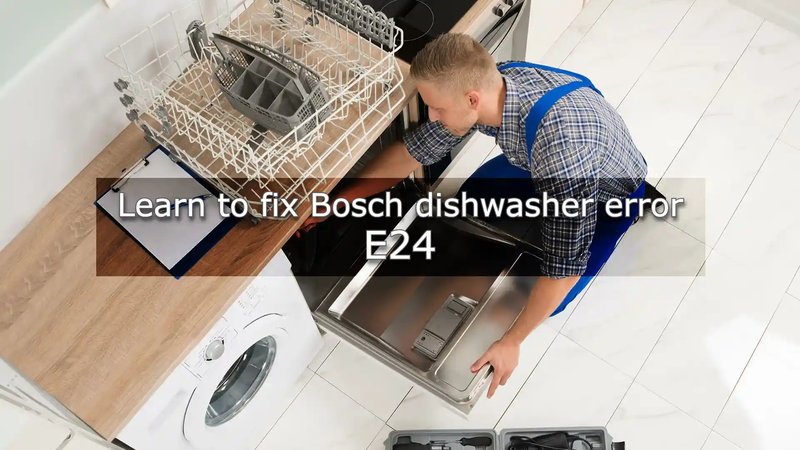
Error OE in Bosch dishwashers generally indicates a problem with water drainage. Simply put, your dishwasher is having trouble getting all that dirty water out, leaving you with a soggy mess instead of sparkling clean dishes. It may sound minor, but ignoring this issue could lead to bigger headaches down the road. Just like letting a small leak go unnoticed could lead to water damage in your home, letting Error OE linger might invite more trouble than you bargained for.
Understanding Bosch Dishwasher Error OE
Bosch dishwashers are known for their reliability and efficiency, but even the best appliances can encounter issues. Error OE is a common problem that signifies a drainage issue. Imagine a clogged kitchen sink; water doesn’t drain as it should, causing a backup. Your dishwasher faces a similar situation when Error OE appears. This error often means there’s a blockage or malfunction in the drainage system, preventing the water from exiting properly.
Water may be pooling at the bottom of your dishwasher, and it might start to spill over into your kitchen if left unchecked — not the kind of indoor swimming pool you’d want! It’s crucial to address this issue not only to keep your kitchen tidy but also to maintain the health of your appliance. Continued use with this error can lead to even more serious problems, such as flooding and electrical issues, which can be a pain to fix and costly as well.
Moreover, Error OE can indirectly affect the cleanliness of your dishes. A dishwasher struggling to drain could leave residues on your plates and cutlery, defeating the very purpose of having a dishwasher in the first place. So, understanding what Error OE means is the first step towards keeping your kitchen running smoothly.
Common Causes of Error OE
You might be wondering, “What causes Error OE to crop up in the first place?” There are several usual suspects. The most typical culprit is a clogged filter or drain pipe. Just like how a blocked artery can slow down blood flow, a blocked drain slows down water flow. Food particles, soap residue, and other debris can accumulate over time, obstructing the path the water needs to take to exit the appliance.
Another reason could be a faulty pump. Think of the pump as the heart of your dishwasher’s drainage system. It needs to work efficiently to push the water out. If there’s a malfunction, it will struggle to perform its duty, triggering Error OE in the process. Electrical issues can also play a part here if there’s no proper power getting to the pump.
Moreover, kinks or bends in the drain hose can be problematic. A hose that is twisted or improperly installed can prevent smooth water flow, similar to pressing down on a garden hose while watering the plants. Keeping an eye out for these issues and addressing them promptly can often clear up Error OE before it becomes a persistent problem.
Potential Consequences of Ignoring Error OE
Let’s face it, nobody likes dealing with appliance errors. It’s tempting to just ignore the blinking light and hope it goes away. But here’s the deal: ignoring Error OE could lead to more than just dirty dishes. Water that doesn’t drain properly can cause internal damage to your dishwasher. Just as unchecked rust can eat through metal, lingering water can ruin the internal components of your appliance over time.
Beyond that, there’s the risk of flooding. Imagine coming home to find your kitchen floor transformed into a small lake. If your dishwasher can’t drain, it might overflow, causing water damage to your flooring and potentially leaking into other areas of your home.
Further, persistent drainage issues might lead to mold and bacteria growth inside your dishwasher, given the moisture left behind. This not only creates an unpleasant smell but could also pose health risks. So, while it might seem like a minor inconvenience, fixing Error OE is about averting bigger, costlier problems in the future.
How to Fix and Prevent Error OE
The good news is, in many cases, you can fix Error OE with some straightforward troubleshooting. Start by checking the dishwasher’s filter and drain for clogs. Cleaning these parts regularly is akin to brushing your teeth to avoid cavities; it’s a simple habit that prevents bigger issues. Make sure to disconnect power before investigating to ensure safety.
Next, take a look at the drain hose. Ensure it’s free of kinks and properly connected. If everything seems fine, the pump might need a closer inspection. While some of these checks can be done at home, don’t hesitate to call a professional if you’re out of your depth. Sometimes, a technician’s expertise is necessary to diagnose and repair intricate problems.
Prevention is also key. Make it a routine to clean your dishwasher’s filter and check the drain hose from time to time. Run a dishwasher cleaner through the machine to keep build-up at bay and ensure everything runs smoothly. This simple maintenance can go a long way in keeping Error OE, and other potential errors, at bay, giving you peace of mind and a happy kitchen.
In conclusion, while Error OE can be a nuisance, it’s also a warning sign that your dishwasher needs attention. Addressing the issue promptly not only keeps your kitchen functioning smoothly but also prolongs the life of your appliance. So next time that error flashes, remember it’s more than just a code — it’s your dishwasher asking for a little TLC.